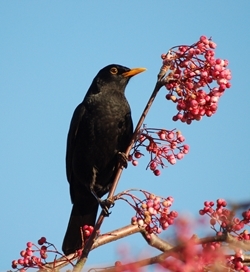 An army of more than 2,000 farmers and gamekeepers who registered to take part in the Game & Wildlife Conservation Trust’s Big Farmland Bird Count will be out in force this week between 7 – 15th February to see how their conservation efforts are helping some of our most rapidly declining birds.
An army of more than 2,000 farmers and gamekeepers who registered to take part in the Game & Wildlife Conservation Trust’s Big Farmland Bird Count will be out in force this week between 7 – 15th February to see how their conservation efforts are helping some of our most rapidly declining birds.
Early results from those returning count forms this weekend show that farmers taking part have already recorded seeing 117 different types of birds, and encouragingly, 14 red-listed data species have been counted. These included linnet, yellowhammer, starling and lapwing. Blackbirds have been recorded on 92% of farms taking part in the survey so far.
Jim Egan, Head of Training & Development with the Game & Wildlife Conservation Trust (GWCT) said, “At this early stage in the count this was a remarkable result both in terms of the range of species counted as well as the number of red-listed species appearing within the top 25 of birds seen.”
Guy Smith, Vice-Chairman of the National Farmers’ Union was one of the first farmers to submit his count to the Game & Wildlife Conservation Trust yesterday. He said, “The GWCT’s Big Farmland Bird Count was a wonderful opportunity to take some time out on my farm and appreciate how my conservation efforts are helping my birds.
“It was thrilling to see flocks of lapwing and in total I was surprised to record more than 24 different bird species including curlew, barn owls and even a heron. I often hear farmers grumble that while they are quietly proud of how much wildlife they have on their farms they get fed up with reports that modern farming is bad for birds. But to my mind the answer is, don't just be proud - be loud. We're always interested in how many tonnes of wheat we can get to the hectare, now let's systematically record how many bird species we can achieve per farm and send the results back to the GWCT.”
Jim Egan, Head of Development and Training with the Trust said “There has been an enormous sea-change in the way many farmers now manage their land to benefit wildlife and through the Big Farmland Bird Count, we wanted to give them an opportunity of show-casing what their conservation efforts deliver on the ground.
“Farmers like gamekeepers are absolutely crucial to the survival of many of our very threatened bird species. But in our view to make change happen, it is essential to do this in a very positive way. The Big Farmland Bird Count achieves this by giving farmers an opportunity of seeing what they have got, understanding better what they need to deliver and making them feel very proud of their achievements. In so doing, the hope is that they will want to do more. Once you get into that cycle, you know you are winning.”
As well as monitoring the effect of conservation schemes on their farms, participating in the GWCT’s Big Farmland Bird count is a very satisfying way for people to discover the wide variety of bird species that live on a farmthere.
Jim Egan said, “The result of spending just a short time monitoring your birds can be surprising. We hope it will spur people on to do even more work for their farmland birds in the future. As a research charity, we also feel it is important for farmers to build up their own long-term data records. This will give them personal insight on what their efforts are achieving against a backdrop of profitable farming businesses.”
For those interested in taking part in the Big Farmland Bird Count, between 7th and 15th February, the GWCT is providing a simple tick sheet that can be downloaded from the GWCT’s website (www.gwct.org.uk/BFBC) and taken into the field for 30 minutes to record any sightings. Participants will then be able to send the results either via a dedicated web page or through the post. The results of the 2015 Big Farmland Bird Count will be announced in early spring.
The GWCT’s Big Farmland Bird Count has captured the imagination of all those interested in the future of farmland birds. Sponsored by BASF, the count is run in partnership with the FWAG Association and LEAF and receives grateful support from a wide range of farming and industry organisations such as RSPB, Kings, Waitrose, NFU, Soil Association, CFE, CLA, Heather Trust, Conservation Grade, and Countryside Alliance .
To register interest and download count forms, please visit: www.gwct.org.uk/BFBC or telephone: 01425 651011. For media enquiries please call Morag Walker on 07736 124097.
END
Photocaption: More than 2,000 farmers and gamekeepers have registered to take part in the 2015 Big Farmland Bird Count being organised by the Game & Wildlife Conservation Trust this week. So far blackbirds have been seen on 96% of farms taking part in the survey. Photo credit: Peter Thompson, GWCT.
Notes to editors
The Game & Wildlife Conservation Trust – providing research-led conservation for a thriving countryside. The GWCT is an independent wildlife conservation charity which has carried out scientific research into Britain’s game and wildlife since the 1930s. We advise farmers and landowners on improving wildlife habitats. We employ more than 60 post-doctoral scientists and other research staff with expertise in areas such as birds, insects, mammals, farming, fish and statistics. We undertake our own research as well as projects funded by contract and grant-aid from government and private bodies.
For information, contact:
Eleanor Williams
Telephone: 07592 025476
Email: press@gwct.org.uk